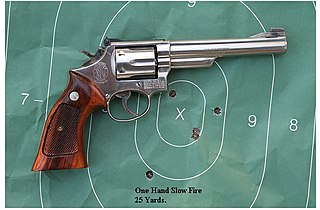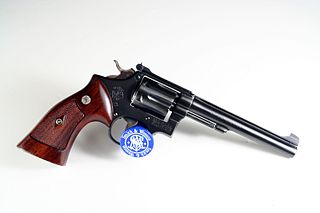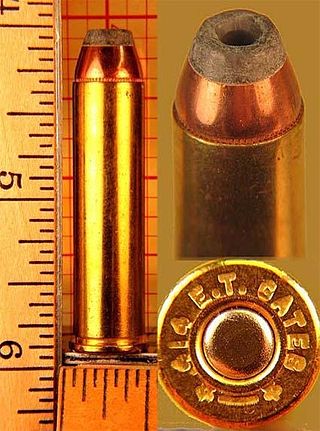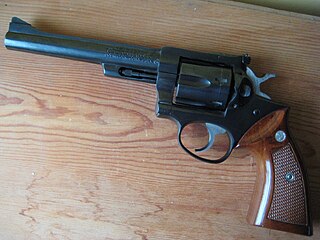
The .38 Special, also commonly known as .38 S&W Special, .38 Smith & Wesson Special, .38 Spl, .38 Spc,, or 9x29mmR is a rimmed, centerfire cartridge designed by Smith & Wesson.

Smith & Wesson Brands, Inc. (S&W) is an American firearm manufacturer headquartered in Springfield, Massachusetts, United States.

The .357 Smith & Wesson Magnum, .357 S&W Magnum, .357 Magnum, or 9×33mmR, is a smokeless powder cartridge with a 0.357 in (9.07 mm) bullet diameter. It was created by Elmer Keith, Phillip B. Sharpe, and Douglas B. Wesson of firearm manufacturers Smith & Wesson and Winchester. The .357 Magnum cartridge is notable for its highly effective terminal ballistics.

The .44 Remington Magnum, also known as .44 Magnum or 10.9x33mmR, is a rimmed, large-bore cartridge originally designed for revolvers and quickly adopted for carbines and rifles. Despite the ".44" designation, guns chambered for the .44 Magnum round, its parent case, the .44 Special, and its parent case, the .44 Russian all use 0.429 in (10.9 mm) diameter bullets. The .44 Magnum is based on the .44 Special case but lengthened and loaded to higher pressures for greater velocity and energy.

The .44 Smith & Wesson Special, also commonly known as .44 S&W Special, .44 Special, .44 Spl, .44 Spc, or 10.9×29mmR, is a smokeless powder center fire metallic revolver cartridge developed by Smith & Wesson in 1907 as the standard chambering for their New Century revolver, introduced in 1908.

The .41 Remington Magnum, also known as .41 Magnum or 10.4×33mmR, is a center fire firearms cartridge primarily developed for use in large-frame revolvers, introduced in 1964 by the Remington Arms Company, intended for hunting and law enforcement purposes.

The Smith & Wesson Model 19 is a revolver produced by Smith & Wesson that was introduced in 1957 on its K-frame. The Model 19 is chambered for .357 Magnum. The K-frame is somewhat smaller and lighter than the original N-frame .357, usually known as the Smith & Wesson Model 27. A stainless steel variant of the Model 19, the Smith & Wesson Model 66, was introduced in 1971.

The Smith & Wesson Model 586, is a six- or seven-shot double-action revolver chambered for the .357 Magnum cartridge; it will also chamber and fire .38 Special cartridges. The Model 586 has a carbon steel construction and is available in a blued or nickel finish; it is essentially the same firearm as the Model 686, which has stainless steel construction. It is also known as the Distinguished Combat Magnum.

The Smith & Wesson Model 15, initially the Smith & Wesson K-38 Combat Masterpiece, is a six-shot double-action revolver with adjustable open sights produced by Smith & Wesson on the medium-size "K" frame. It is chambered for the .38 Special cartridge and is fitted with a 4-inch (100 mm) barrel, though additional barrel options have been offered at various times during its production. It is essentially a shorter barrel version of the Smith & Wesson Model 14 and an adjustable-sight version of the seminal Smith & Wesson Model 10 with target shooting features.

The Smith & Wesson Model 17 is a six-shot double-action revolver chambered for .22 LR. It is built on Smith & Wesson's medium-sized K-frame.

The Ruger Blackhawk is a six-shot, single-action revolver manufactured by Sturm, Ruger & Co. It is produced in a variety of finishes, calibers, and barrel lengths.

The GP100 is a family/line of double action five-, six-, seven-, or ten-shot revolvers made by Sturm, Ruger & Co., manufactured in the United States. Since its introduction, it has been produced with a number of variations including various barrel lengths and profiles, fixed or adjustable sights, and in blued carbon steel or stainless steel.

The Ruger Redhawk is a DA/SA, large-frame revolver introduced in 1979 by Sturm, Ruger & Company. Made from high-grade steel, it is available in a stainless steel finish. The Redhawk is reinforced to handle extra stress, making it very popular for use by handloaders as it is able to handle both .45 Colt and .44 Magnum loads. In addition, the cylinder itself is longer than most competitors', allowing ammunition to be loaded to a longer overall length. This allows for either increased powder capacity, heavier bullets without compromising the powder load, or a combination of both. Custom ammunition manufacturers even have loads made specifically for Ruger revolvers that cannot fit in shorter chambers or revolvers of weaker construction. This makes the Redhawk popular as a bear defense gun among hunters and trappers.

S&W Centennial is a family of revolvers made by Smith & Wesson on the "J-Frame". Depending upon caliber, the cylinder holds either 5, 6, 7, or 8 cartridges. Centennials feature a fully enclosed (internal) hammer, which makes them Double Action Only (DAO) firearms. Like all other "J-frame" Smith & Wesson revolvers, they have a swing-out cylinder. Centennial models have been made in different versions like PD "Personal Defense", LS "Lady Smith", and M&P "Military & Police"

A handgun is a firearm designed to be usable with only one hand. It is distinguished from a long gun which needs to be held by both hands and braced against the shoulder. The two most common types of handguns are revolvers and semi-automatic pistols, although other types such as derringers and machine pistols also see infrequent usage.

The Colt Trooper is a medium frame, double-action revolver featuring a six-round cylinder, chambered for .22 Long Rifle, .22 Winchester Magnum Rimfire, .38 Special, and .357 Magnum caliber cartridges. Designed as a less expensive alternative to the upscale Colt .357 and the later Colt Python and Colt King Cobra, it was marketed to law enforcement agencies as well as civilians.

A super magnum is a longer and/or more powerful version of a "magnum" cartridge. Although the term "super magnum" typically refers to a handgun cartridge, created by lengthening an existing straight-case design, it can also refer to rifle and shotgun cartridges, such as the .17 Winchester Super Magnum and the 31⁄2" 12 Gauge Super Magnum. In this case, it simply denotes that it is of greater power than existing "magnums" of similar caliber, similar to other designations such as "Remington Ultra Magnum". The most widespread of these cartridges are the "SuperMag" family of super-magnum handgun cartridges that were proposed and tested by Elgin Gates in the 1970s.

The Smith & Wesson Model 57 is a large frame, double-action revolver with a six round cylinder, chambered for the .41 Magnum cartridge, and designed and manufactured by the Smith & Wesson firearms company. The gun was designed as a weapon for law enforcement agencies. However, due to size and recoil it found more favor with civilian target shooters and hunters.

The Ruger Security-Six and its variants, the Service-Six and Speed-Six are a product line of double-action revolvers introduced in 1972 and manufactured until 1988 by Sturm, Ruger & Co. These revolvers were marketed to law enforcement duty issue, military, and civilian self-defense markets.
The .500 S&W Magnum or 12.7×41mmSR is a .50 caliber semi-rimmed revolver cartridge developed by Cor-Bon in partnership with the Smith & Wesson "X-Gun" engineering team for use in the Smith & Wesson Model 500 X-frame revolver and introduced in February 2003 at the SHOT Show. From its inception, it was intended to be the most powerful handgun cartridge to date, with the capacity to harvest all North American game species. While more powerful handgun cartridges, such as the .500 Bushwhacker, have emerged since, they are only available in custom firearms, and the .500 S&W remains the most powerful production handgun cartridge.



















